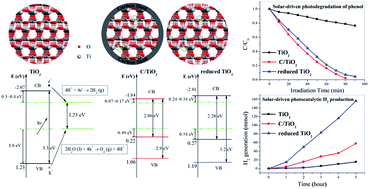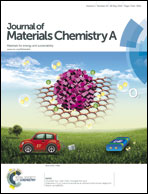Enhancing photocatalytic activity of disorder-engineered C/TiO2 and TiO2 nanoparticles†
Abstract
We demonstrate a simple and green synthetic pathway to prepare TiO2–carbon nanoparticles (C/TiO2 NPs) by the sol–gel method, abandoning additional carbon sources but utilizing the organic group in the Ti precursor. Then the C/TiO2 NPs were decarburized under an air atmosphere at 500 °C for 2 h to form the reduced TiO2 nanoparticles. XRD, Raman spectrum, HRTEM and electron energy loss spectrum (EELS) analyses showed that the C/TiO2 NPs were composites of core-shell structured TiO2 and amorphous carbon; and both C/TiO2 and reduced TiO2 NPs contained a large number of oxygen vacancies, which led to structural disorders in them. These structural disorders induced the valence band tails to enhance visible light absorption and to tailor the bandgap structures of the two modified TiO2 samples to match the hydrogen and oxygen production energy levels. As a result, the two structure-disordered C/TiO2 and reduced TiO2 nanocrystals showed excellent solar-driven photocatalytic activities: the C/TiO2 performed best on the photodegradation of phenol and methyl blue, while the reduced TiO2 displayed an excellent hydrogen generation rate, 10 times higher than that of the reference TiO2 by photo-splitting water.


 Please wait while we load your content...
Please wait while we load your content...